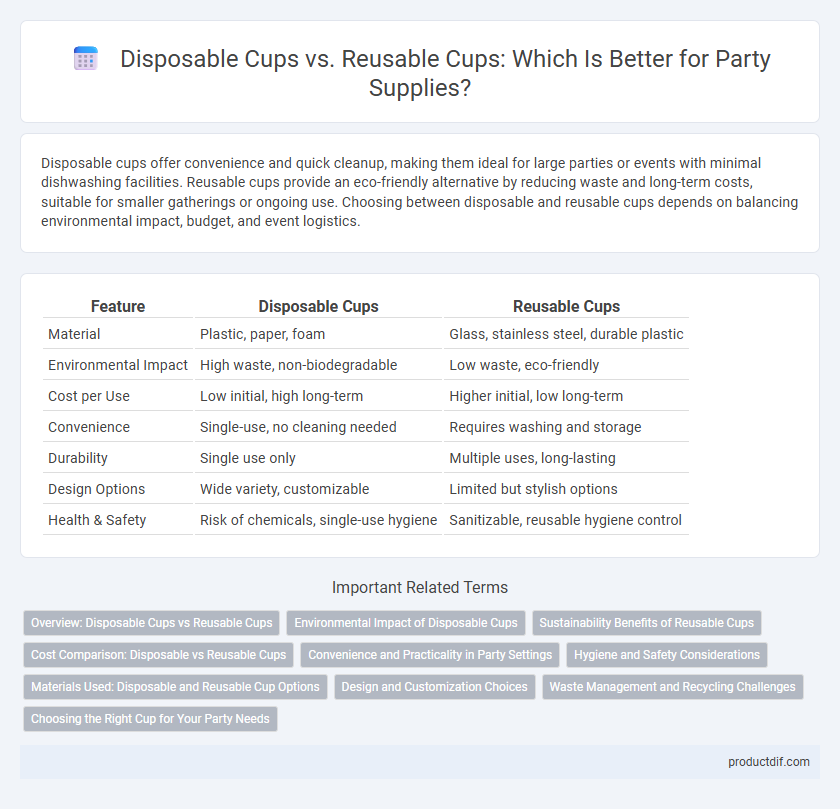Disposable cups offer convenience and quick cleanup, making them ideal for large parties or events with minimal dishwashing facilities. Reusable cups provide an eco-friendly alternative by reducing waste and long-term costs, suitable for smaller gatherings or ongoing use. Choosing between disposable and reusable cups depends on balancing environmental impact, budget, and event logistics.
Table of Comparison
| Feature | Disposable Cups | Reusable Cups |
|---|---|---|
| Material | Plastic, paper, foam | Glass, stainless steel, durable plastic |
| Environmental Impact | High waste, non-biodegradable | Low waste, eco-friendly |
| Cost per Use | Low initial, high long-term | Higher initial, low long-term |
| Convenience | Single-use, no cleaning needed | Requires washing and storage |
| Durability | Single use only | Multiple uses, long-lasting |
| Design Options | Wide variety, customizable | Limited but stylish options |
| Health & Safety | Risk of chemicals, single-use hygiene | Sanitizable, reusable hygiene control |
Overview: Disposable Cups vs Reusable Cups
Disposable cups offer convenience and quick cleanup, making them ideal for large parties or events where time and resources are limited. Reusable cups provide an eco-friendly alternative that reduces waste and can be more cost-effective over time, especially for frequent use. The choice between disposable and reusable cups depends on factors such as environmental impact, budget, and event scale.
Environmental Impact of Disposable Cups
Disposable cups contribute significantly to environmental pollution due to their short usage span and difficulty in recycling, often ending up in landfills or oceans. Made primarily from plastic or coated paper, these cups release harmful chemicals and microplastics during decomposition, impacting ecosystems and wildlife. Increasingly, eco-conscious consumers and event organizers are shifting towards sustainable alternatives to reduce waste and carbon footprints associated with single-use cup production and disposal.
Sustainability Benefits of Reusable Cups
Reusable cups significantly reduce waste by minimizing single-use plastic and paper cup consumption, which often end up in landfills and oceans. They lower carbon footprints through decreased manufacturing demand and resource extraction, contributing to long-term environmental sustainability. By choosing durable materials like stainless steel or BPA-free plastic, reusable cups promote eco-friendly party supplies that support sustainable event planning.
Cost Comparison: Disposable vs Reusable Cups
Disposable cups often have a lower upfront cost but generate higher long-term expenses due to constant repurchasing for each event. Reusable cups require a higher initial investment but offer cost savings over time through multiple uses and reduced waste disposal fees. Choosing between disposable and reusable cups depends on event frequency, budget constraints, and environmental considerations.
Convenience and Practicality in Party Settings
Disposable cups offer unmatched convenience in party settings due to their single-use nature, eliminating the need for washing and reducing cleanup time significantly. Reusable cups provide practicality by being eco-friendly and durable, suitable for multiple-party uses and reducing overall waste. Choosing between disposable and reusable cups depends on balancing convenience with environmental impact and party size.
Hygiene and Safety Considerations
Disposable cups offer superior hygiene by eliminating the risk of cross-contamination and bacterial buildup since they are used once and discarded. Reusable cups require thorough cleaning and sanitization after each use to ensure safety, which can sometimes be inconsistent in party settings. Choosing disposable cups minimizes health risks at gatherings where quick turnover and cleanliness are paramount.
Materials Used: Disposable and Reusable Cup Options
Disposable cups are typically made from materials such as paper lined with polyethylene, polystyrene foam, or biodegradable plant-based plastics like PLA, providing convenience but often contributing to environmental waste. Reusable cups are usually crafted from durable materials including stainless steel, silicone, glass, or BPA-free plastic, designed to withstand repeated use and reduce single-use plastic consumption. Choosing the right material balances party convenience with eco-friendly practices, influencing waste management and sustainability.
Design and Customization Choices
Disposable cups offer a wide range of vibrant colors and patterns perfect for themed parties, allowing easy customization with logos, slogans, or personalized designs through printing or stickers. Reusable cups provide more sophisticated design options, including engraved, embossed, or multi-layered patterns, and support customization through durable paint, etching, or removable decals. Both options cater to unique party aesthetics, but reusable cups often deliver higher-quality finishes and lasting personalization for repeated use.
Waste Management and Recycling Challenges
Disposable cups generate significant waste due to their single-use nature, often ending up in landfills or as litter, complicating waste management efforts. Reusable cups, while reducing waste volume, require proper cleaning and maintenance to ensure longevity and hygiene, presenting challenges in consistent user compliance. Recycling disposable cups is difficult because many are lined with plastic, hindering material recovery and necessitating specialized facilities that are not widely available.
Choosing the Right Cup for Your Party Needs
Disposable cups offer convenience, quick cleanup, and are ideal for large gatherings or outdoor events where washing facilities are limited. Reusable cups provide sustainability benefits, reducing waste and long-term costs, making them perfect for smaller, eco-conscious parties or events with access to dishwashing. Assess the event size, environmental impact, and budget to select the most suitable cup option for your party needs.
Disposable cups vs Reusable cups Infographic

 productdif.com
productdif.com